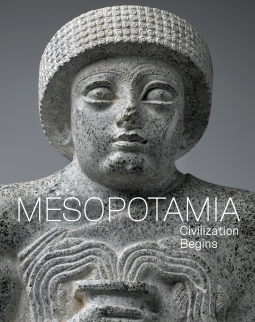When the mythic become tangible. [Mesopotamia: Civilization Begins edited by Ariane Thomas and Timothy Potts]
Mesopotamia, in modern-day Iraq, was home to the remarkable ancient civilizations of Sumer, Akkad, Babylonia, and Assyria. From the rise of the first cities around 3500 BCE, through the mighty empires of Nineveh and Babylon, to the demise of its native culture around 100 CE, Mesopotamia produced some of the most powerful and captivating art of antiquity and led the world in astronomy, mathematics, and other sciences—a legacy that lives on today.
Mesopotamia: Civilization Begins presents a rich panorama of ancient Mesopotamia’s history, from its earliest prehistoric cultures to its conquest by Alexander the Great in 331 BCE. This catalogue records the beauty and variety of the objects on display, on loan from the Louvre’s unparalleled collection of ancient Near Eastern antiquities: cylinder seals, monumental sculptures, cuneiform tablets, jewelry, glazed bricks, paintings, figurines, and more. Essays by international experts explore a range of topics, from the earliest French excavations to Mesopotamia’s economy, religion, cities, cuneiform writing, rulers, and history—as well as its enduring presence in the contemporary imagination.
This volume is published to accompany an exhibition on view at the J. Paul Getty Museum at the Getty Villa March 18 to July 27, 2020.Meant to accompany an exhibition at the Getty Villa, Mesopotamia: Civilization Begins, edited by Ariane Thomas and Timothy Potts, is a exploration of the history of the region through its various empires and the advances in art and writing that were seen throughout. A collection of essays precedes itemizations of pieces in the exhibit, often contextualize historically both stylistically and in terms of procurement. The publication also touches on academic issues and trends in the study of Mesopotamia and in preservation of respective relics.
As the world moves through the COVID-19 pandemic, museums have been some of the most visible affected in the artistic world. Appropriately the Getty Museum has closed its exhibitions. The respective exhibit, Mesopotamia: Civilization Beings, is also temporarily closed. As the museum began its closure March 14th, the exhibit, originally set from the 18th of March to the 27th of July, never opened. As such I can only imagine how appropriate the publication might have been as an accompanying guidebook. Were I roaming the exhibition floor with this book in tow, or had I seen the exhibit and decided to take the publication home with me for more detail, I think that context would have cemented a high rating for this book.
Before my read I barely knew a thing of the history of Mesopotamia, its timelines and various successive forms. I am walking away from my read with a firmer sense of the region and its history in the global timeline I keep running in my head. A firmer sense yes, but a clear one? Maybe not so much. I think this book reads best as geared towards an academic audience. As a layperson I didn't connect so much with the book. I didn't have intense moments of erudition or realization. I learned, but very much on a surface level.
The quality of the artifacts is a reflection of the ancient history of the subject of Mesopotamia. Aging, faded, and reconstructed stone, clay, and metal works make up a generally homogeneous collection. Personally I enjoyed the history told much more than the items on display. For me this was a 3 star book. I would have much preferred expanded essays that incorporated the items throughout as opposed to an inventory of the exhibition. Histories are forever. Maybe.
Mesopotamia: Civilization Begins was set for publication April 3rd, 2020.

Comments
Post a Comment